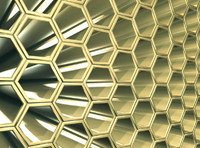Home > Press > Nanotechnology: wear protection and anti-friction properties for metal components using DOSGLIDE PLUS treatment
 |
| Nano-surface treatment for metal components |
Abstract:
Nanotechnology opens up new possibilities for the surface treatment of metal components whenever anti-adhesion properties, increased wear resistance and anti-friction is required.
Nanotechnology: wear protection and anti-friction properties for metal components using DOSGLIDE PLUS treatment
Waldkirch, Germany | Posted on August 17th, 2008These properties can be obtained by controlled embedding of PFA (Perfluoralcoxy-Copolymers). The difference to common coatings is that the treatment is performed to the precise tolerances of the workpiece at +/- 1 µm. This means that also small pieces or components with complex geometries can be prepared.
The fields of application are numerous: from gear pieces, meshes over receptacles and pipes to components in fine mechanics.
Specifications
> Hardness in micro Vickers: approx. 650 HV
> Hardness in micro Vickers after heat treatment: approx. 1050 HV max.
> Chemical resistance: > PH 4.0
> Layer thickness: 25-50 µm
> Temperature resistance: 300°C / 572°F, peaks 340°C / 645°F
> Adhesion test: > 38 N/mm2
> PH resistance: 4 - 14
> Resistance to wear (sliding pin test): excellent (0.49 µ/Km)
> Anti-ahesive characteristics: excellent
> Corrosion protection: good
> Fouling resistance: excellent
####
For more information, please click here
Contacts:
PIETER VAN WEENEN & CO. GmbH
Fabrik Sonntag 3
D-79183 Waldkirch
Copyright © PIETER VAN WEENEN & CO. GmbH
If you have a comment, please Contact us.Issuers of news releases, not 7th Wave, Inc. or Nanotechnology Now, are solely responsible for the accuracy of the content.
| Related News Press |
News and information
![]() Researchers develop molecular qubits that communicate at telecom frequencies October 3rd, 2025
Researchers develop molecular qubits that communicate at telecom frequencies October 3rd, 2025
![]() Next-generation quantum communication October 3rd, 2025
Next-generation quantum communication October 3rd, 2025
![]() "Nanoreactor" cage uses visible light for catalytic and ultra-selective cross-cycloadditions October 3rd, 2025
"Nanoreactor" cage uses visible light for catalytic and ultra-selective cross-cycloadditions October 3rd, 2025
Materials/Metamaterials/Magnetoresistance
![]() First real-time observation of two-dimensional melting process: Researchers at Mainz University unveil new insights into magnetic vortex structures August 8th, 2025
First real-time observation of two-dimensional melting process: Researchers at Mainz University unveil new insights into magnetic vortex structures August 8th, 2025
![]() Researchers unveil a groundbreaking clay-based solution to capture carbon dioxide and combat climate change June 6th, 2025
Researchers unveil a groundbreaking clay-based solution to capture carbon dioxide and combat climate change June 6th, 2025
![]() A 1960s idea inspires NBI researchers to study hitherto inaccessible quantum states June 6th, 2025
A 1960s idea inspires NBI researchers to study hitherto inaccessible quantum states June 6th, 2025
![]() Institute for Nanoscience hosts annual proposal planning meeting May 16th, 2025
Institute for Nanoscience hosts annual proposal planning meeting May 16th, 2025
Announcements
![]() Rice membrane extracts lithium from brines with greater speed, less waste October 3rd, 2025
Rice membrane extracts lithium from brines with greater speed, less waste October 3rd, 2025
![]() Researchers develop molecular qubits that communicate at telecom frequencies October 3rd, 2025
Researchers develop molecular qubits that communicate at telecom frequencies October 3rd, 2025
![]() Next-generation quantum communication October 3rd, 2025
Next-generation quantum communication October 3rd, 2025
![]() "Nanoreactor" cage uses visible light for catalytic and ultra-selective cross-cycloadditions October 3rd, 2025
"Nanoreactor" cage uses visible light for catalytic and ultra-selective cross-cycloadditions October 3rd, 2025
|
|
||
|
|
||
| The latest news from around the world, FREE | ||
|
|
||
|
|
||
| Premium Products | ||
|
|
||
|
Only the news you want to read!
Learn More |
||
|
|
||
|
Full-service, expert consulting
Learn More |
||
|
|
||








